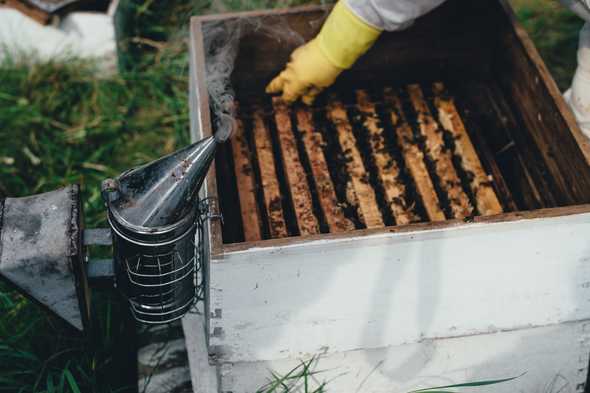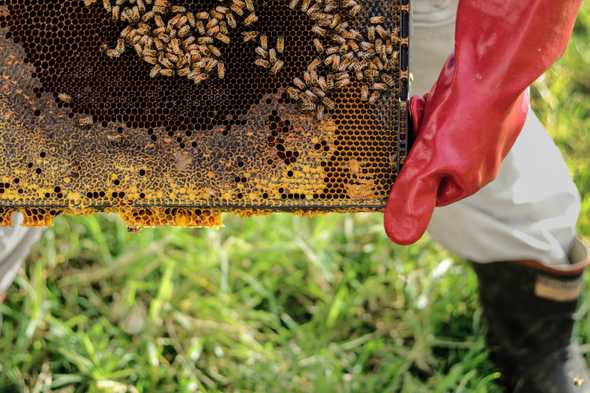Bozbark
Beginning Beekeeping
December 28, 2018
This coming spring I plan to start a beehive. I have no experience with keeping bees. I wanted to document the process in hopes that it could be helpful for others interested in trying.
What You Will Need
- Beekeeper’s Tool
- Hive
- Beekeeper’s Hat
- Gloves
- Bee Smoker
- Bees
- Bee Feeder
- Brush
Picking Your Hive
Picking the hive size all depends on your preference. How much do you think you can handle going in to your first hive? There seem to be several variations of traditional hives. Man-made beehives are wood and built in stackable sections called nucs. Each nuc holds a certain number of frames based on it’s size. Frames are wooden rectangles that the bees will build their comb on to store honey, pollen, eggs, and brood. I am going to start out with a 10 frame hive meaning that my nucs will each be wide enough to hold 10 frames each. There are some nucs made for as little as 4 frames, so if 10 seems too large, you could always pick a smaller hive size.
Picking Your Bees
There are a lot of variety in bees. You will want to read about what type of bee you think will best fit your climate, and foliage type. There are places online to order your bees that will ship to your house. If possible try to look around your area for a beekeeping association or club and buy bees from a member there. It is better to buy from someone who you can ask questions. The bees are already acclimated to your climate and foliage type if you buy local.
Check Your Area’s Beekeeping Laws
The area I live in requires that you register each of your hives with the plant association. Not doing so could result in fines related to mistreated/unregistered livestock. In my area the registration required completion of a packet that gives great info about getting started.
Preparing Your Hive
Bees hibernate in the winter, so you will want to start your hive in early spring. This will give them enough time to establish themselves for their first winter with you. You will want to make sure the hive is set up completely and is in a place protected from the wind. Try to put the hive in a location that has winter sun to help keep the bees as warm as possible during the colder months. You will want to prepare a sugar-water mixture for when the bees first get put into their new homes. There is a saying for knowing how much sugar to add to your water “A pint to a pound makes the world go ‘round”. This means to add a pound of sugar for each pint of water you are going to feed your bees.
Adding Your Bees
Take your box of bees and remove the queen. She should be in a separated container within your box of bees. There will be a small cork blocking the other bees from accessing her container. Remove this cork. There should be a candy divider that remains. The bees eat through this divider of the next 3-4 days to release the queen. This is so that the bees don’t kill the queen. The hive doesn’t know who their queen is and it takes a while to get to know her.
Once you have uncorked the queen’s container, place her on the bottom/side of one of your frames. You can attach the box in anyway you need to. Dump the bees out of their box into their new hive and brush them between the frames. Place the lid on the nuc, place the feeder on the lid, then cover the hive with the top. Make sure to weigh the top down with something heavy so it isn’t blown off.
Come back in a week to check on your hive. There should be comb and eggs in your hive!
Helping Out Your Bees
If you didn’t know, bees need nectar from flowing plants to make their honey. Depending on where you live, nectar may be a rare resource. You can help your bees by planting your own flowing plants that will allow them to gather nectar. Planting herbs that go to flower are great ways to provide nectar for your bees. Here are some plants that they enjoy:
- Oregano
- Mint
- Rosemary
- Thyme
- Sage
- Parsley
- Chives
- Lavender
- Sunflowers
- Marigolds
- Bee Balm
If you have the space for it, also consider planting fruit-bearing trees. They are great for helping out your bees plus they can provide you with some tasty treats. (Some fruit trees won’t produce fruit without the help of bees!) Cherry, pear, apple, and peach are all good options.
A Warning About Your Plants:
If you grow plants, make sure you are NOT using pesticides. This will kill your bees. It is also important to note a study found that nearly 50% of plants from big-name garden retailers contained pesticides deadly to honey bees. Make sure if you are growing your plants you buy local and ask the owner if they use pesticides. Growing from seed is also always a good option.
Good luck with your bee hive. Again, get involved with a bee organization near you so you can ask questions and get help when you need it. 🐝🍯
An Ozarker writing about self-reliance, doing things that are meaningful, and staying connected to reality in a digital world.
Check Out Our Merch


